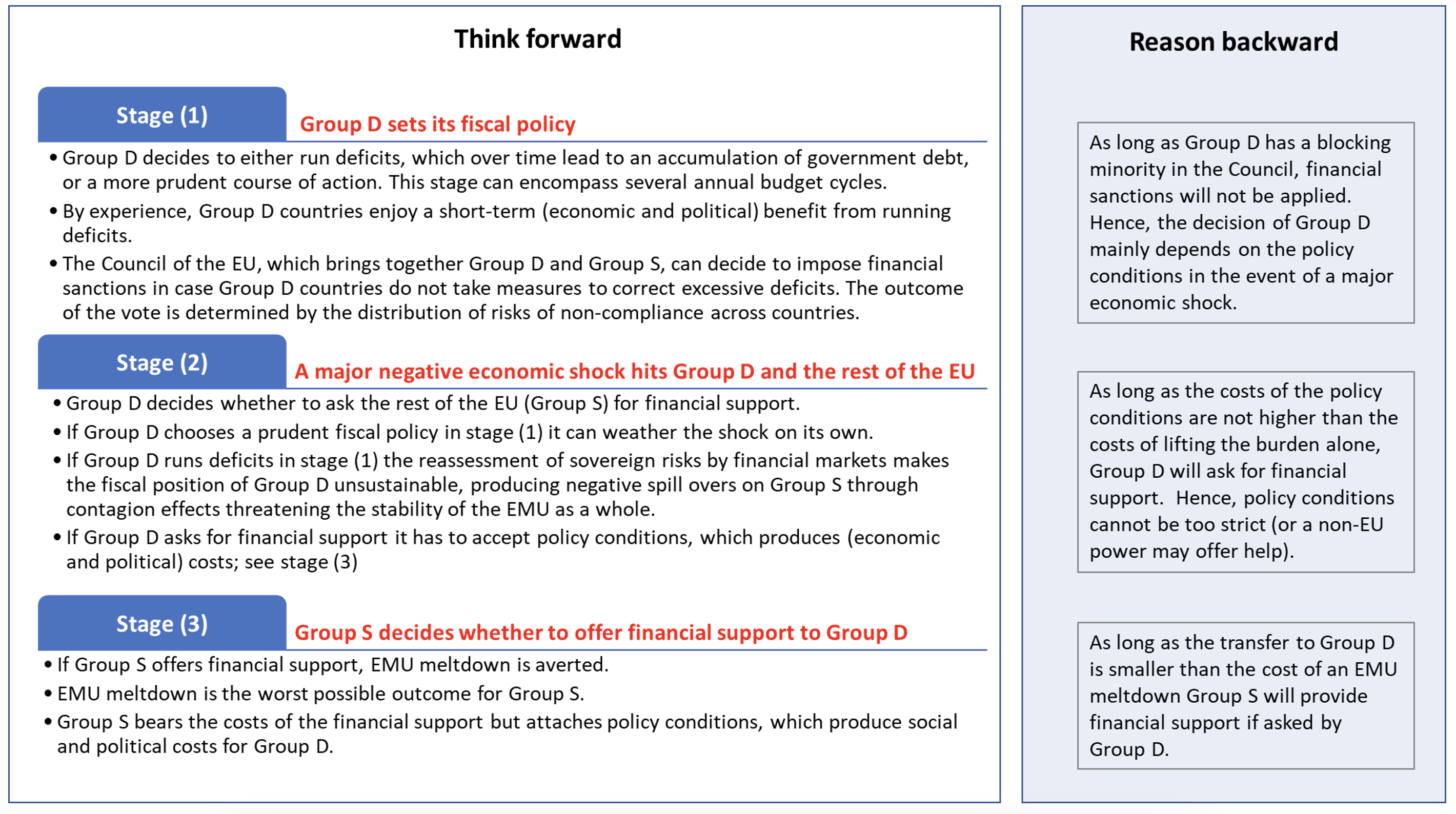The effectiveness of fiscal rules crucially hinges on their enforceability. This notion looms large in the relevant literature starting with the seminal work by Kopits and Symansky (1998), who characterised the stylised profile of an ‘ideal’ fiscal rule. It also applies to the Stability and Growth Pact (SGP), a coordination device of the EU aimed to ensure the smooth functioning of the Economic and Monetary Union (EMU).
From today’s perspective, the track record of the SGP has been mixed at best. Since inception, some member states have regularly and significantly deviated from the course of action implied by the EU fiscal rules (Larch et al. 2023). Yet, despite a dismal compliance record by a comparatively small group of countries the EU never managed to deploy the financial sanctions set out in the SGP.
Right now, the EU’s fiscal framework is on the cusp of a new legislative reform – the fourth – where the objective of strengthening enforcement features prominently once again. The official narrative underpinning the reform proposal underscores stronger enforcement via a more consistent recourse to financial sanctions as the necessary counterweight to more flexible and country-specific fiscal adjustment requirements.
Drawing on basic elements of game theory, in a recent paper we show that all valiant attempts to strengthen the SGP’s enforcement will produce limited effects unless a number of politically charged but fundamental issues are addressed (Kirchsteiger and Larch 2023). The EU needs to find credible ways to (i) consistently impose meaningful sanctions in the event of non-compliance; (ii) link financial support in the wake of major shocks to a meaningful but not too harsh degree of macro-conditionality; and, most importantly, (iii) strengthen the resilience of member states to major economic shocks.
The underlying problem of the SGP’s enforcement dilemma is straightforward: countries with a time-tested preference for looser fiscal policy know the risks of non-compliance with the EU fiscal rules are not random, ensuring a blocking minority against the imposition of sanctions. They also know that in the event of a very large negative shock, their own fiscal vulnerability can produce collateral damage for the fiscally prudent countries. Hence, when standing on the brink of a much bigger adversity, the prudent countries will accept paying for the survival of the EMU even if they formally committed not to do so.
A brief flashback
The SGP’s enforcement dilemma has deep roots. It originates in the diverging motivations of the 12 Member States who in the early 1990s decided to introduce the euro. Countries with a propensity to run government deficits supported the introduction of the single currency because, weary of trailing the low inflation policy of the Bundesbank within the European Exchange Rate Mechanism (ERM), they wanted to have a say in the prospective joint monetary authority. In contrast, the Deutschmark bloc, who had enjoyed macroeconomic stability for some time already, wanted to extend its model to the EU as a whole. In essence, two distinct groups of countries sought to export their respective approach of macroeconomic policy making to the other (e.g. Lucarelli 2013, Buti and Larch 2019).
The governance framework emerging from this collision of diverging motivations seemed to tick all boxes necessary to dissuade countries from flouting the fiscal rules: it defined a strict mandate for the ECB with a clear and sole focus on inflation, outlined a procedure for correcting excessive government deficits in the member states – including financial sanctions – and banned any form of monetary financing or bailouts of governments. In addition, to assuage remaining concerns, the then German Finance Minister Theo Waigel convinced his peers and EU leaders to adopt additional legislative provisions aimed to ensure budgetary discipline beyond the broad perimeters set out in the Treaty – the SGP was borne.
The dilemma of SGP enforcement dissected
The dilemma of SGP enforcement can be illustrated by a simple stylised model.
Think of the EU as two groups of countries: Group D tends to run deficits and accumulates growing levels of debt, while Group S runs sustainable fiscal policies.
The implementation of the SGP can be characterised as taking place in three stages.
In stage 1 – it can encompass several annual EU surveillance cycles – Group D decides whether to run a budget deficit or a more prudent fiscal policy. Based on experience, Group D has an incentive to run deficits, i.e. it expects some immediate (economic or political) payoff. If Group D’s policy choices lead to an excessive deficit and the governments do not take corrective measures, the Council of the European Union can impose a fine.
In stage 2, a negative shock hits. If Group D implemented prudent policies in stage 1, it would be able cope on its own regardless of the size of the shock. In contrast, if Group D runs deficits, it is in trouble and can ask Group S for help. In the event of a major downturn, the reassessment of sovereign risks by financial markets makes the fiscal position of Group D unsustainable, producing negative spillovers on Group D through contagion effects threatening the stability of the EMU as a whole.
If Group D asks for help in stage 2, Group S decides whether to help or not in stage 3. If it agrees to help, EMU meltdown is averted. Group S bears the costs of the transfer but attaches certain conditions, which produce social and political costs in Group D.
Figure 1 summarises the different stages of our simple model. The outcome of the strategic interaction between the two groups of countries is revealed by reasoning backward from stage 3. In the event of a major economic downturn, the EMU can collapse for two reasons: either Group S refuses to step in, or Group D does not ask for help. It is plausible to assume that the collapse of the EMU is the worst outcome for Group S. Hence, it will decide to help in stage 3 as long as the transfer to Group D is lower than the damage caused by the EMU collapse.
Group D will ask for help in stage 2 if the macro-conditionality attached to the transfer is not heavier than the costs of lifting the burden alone. This also means that Group S has an incentive not to make conditionality too harsh, because otherwise Group D may refuse help. An interesting corollary of this is that an external power intent on weakening the EU may have an interest in promising help to Group D.
Finally, in stage 1, Group D will decide to run a prudent fiscal policy only if the costs of a possible fine and of macro-conditionality exceed the short term (economic or political) benefits of running a deficit. Since by experience Group D is likely to form a blocking minority in the Council against fines, the decision of pursuing prudent fiscal policies versus accumulating debt boils down to the type of macro conditionality attached to transfers from Group S.
Figure 1 Stylised presentation of SGP implementation
The EU is assumed to consist of two groups of countries: Group D prefers running budget deficits; Group S prefers sustainable public finances
In sum, the dissuasive power of the EU fiscal rules is limited. First, deficit-prone countries command enough votes in the Council to block financial sanctions. Second, they know the EU will not seal its own demise by refusing financial support to troubled countries in the event of a major economic shock. Finally, the macro-conditionality attach to financial support cannot be too strict because receiving countries my find them excessive or drive them into the hands of non-EU powers.
Conclusions
The stylised narrative emerging from our simple model nicely reproduces the main outcomes of SGP implementation since 1997. They highlight the impact of both the political economy in the Council and of systemic risks on the credibility of financial sanctions. They also raise the question of whether the SGP was not bound to fail from the start. To be fair, the group of experts who prepared the blueprint for the EMU – the Delors Committee – had in mind a very different scenario. It did not anticipate the systemic risks that would afflict the EMU during the global financial crisis and after. It also envisaged a completely different implementation of the excessive deficit procedure, namely one that would circumvent the political economy in the Council and rely on “binding” and “enforceable” instruments.
The advent of systemic risks and the political economy in the Council completely changed the enforceability of EU fiscal rules. Our simple model shows why. If we exclude shocks that threaten the existence of the EMU, a ‘no-bailout’ of Group D does not lead to the worst possible outcome for Group S. Second, Group D cannot block fines and the size of sanctions matters.
In the ongoing debate on how to reform the SGP, enforcement plays once again a key role. However, the reform proposal does not aim to address the issues that effectively weigh on the dissuasive power of sanctions. Most importantly, the governance framework around the implementation of the SGP remains unchanged and the initial size of potential sanctions, which deficit-prone countries would have to weigh against the benefit of running deficits, is meant to be reduced. At the same time, very little progress is being made towards strengthening the resilience of EU member states to major economic shocks. In particular, elements fuelling the bank-sovereign doom loop remain largely unaddressed. As long as spillover effects from imprudent fiscal policies in individual member states are not mitigated, the threat of financial sanctions or harsh macro conditionality lack credibility.
Authors’ note: The views expressed in this column do not necessarily reflect those of the European Commission or of the European Fiscal Board.
References
Buti, M and M Larch (2019), “The Economic Governance of the Euro Area”, in G Amato, E Mavero-Milanesi, G Pasquino and L Reichlin (eds), The History of the European Union, Bloomsbury Publishing.
Kirchsteiger, G and M Larch (2023), “The enforcement dilemma of EU fiscal rules”.
Kopits, G and S A Symansky (1998), “Fiscal Rules”, IMF Occasional Paper No. 162.
Larch, M and L Jonung (2014), “Stability and Growth Pact of the European Union”, in The New Palgrave Dictionary of Economics, Palgrave Macmillan.
Lucarelli, B (2013), The endgame for the euro: a critical history, Palgrave MacMillan.
Larch, M, J Malzubris and S Santacroce (2023), “Numerical compliance with the EU fiscal rules: Facts and figures from a new database”, Intereconomics 58(1): 32-42.




